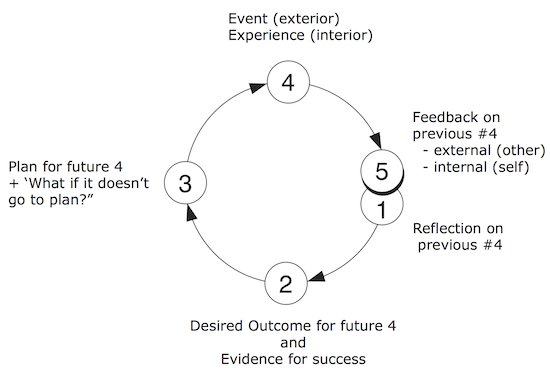Presented at The Developing Group 27 Sep 2014
Reflecting on reflective practice
Reflective practice can be a vital part of professional development. Although it is especially valued in the fields of therapy, coaching, management, healthcare and education (both by teachers and students), there are few jobs in any field that would not benefit from a good dose of reflective practice.
Reflective practice means learning from our own professional experiences. In contrast to traditional teaching and knowledge acquisition, reflective practice can be accomplished almost anywhere, any when. You can do it on your own, with a buddy or in a formal reflective group.
Some advocates highlight the importance of incorporating theory into reflective practice. This can include formal academic theories, and it can also mean testing the value of self-generated models. The process has much in common with Taleb’s idea of conscious “stochastic tinkering”.
Reflective Practice clearly involves ‘reflection’ and its application to ‘practice’. However, other fundamental elements are sometimes undervalued, e.g. ‘feedback’ on the value of the reflective practice. How do you know your reflection is having a beneficial effect on your practice? How can you improve the way you enact your reflective practice? To answer these questions we need to go to a meta-level and apply reflective practice to itself.
During ‘practice’ there is a physical context within which the practitioner and whoever or whatever they are working with are in behavioural relationship. And, there is perceptual context within which the practitioner has a relationship with the topic. For example:
Physical context – Teacher and student interaction
Perceptual context – Teacher’s relationship with teaching.
These are on different logical levels (Bateson).
Our model of Effective Reflective Practice includes both the physical and perceptual context:
Practice (an Event/Experience)
Feedback (internal and external) about the previous event/experience
Reflection on the event/experience and the feedback
Desired Outcome for a future practice
Plan for future desired outcome.

We also asked what a clean approach can bring to the party.
By way of background reading we recommend the wikipedia entry and our article on our PPRC (Perceiver-Perceived-Relationship between-Context) model. A good academic reference is Levels in reflection: core reflection as a means to enhance professional growth, Fred Korthagen and Angelo Vasalos, Teachers and Teaching: theory and practice, Vol. 11, No. 1, February 2005, pp. 47–71.
On the day we considered:
– how you do your reflective practice?
– what models do you use?
– how have you have learned to hone the process?
– how do you facilitate others to reflect on their practice?
Since the Developing Group day we led a workshop sponsored by the Faculty of Education of Masaryk University at Brno, in the Czech Republic. It was attended by facilitators of Reflective Practice for teachers. The theme of the workshop was ’A Clean approach to facilitating reflective practice’. Our slides, which includes more explanation of our model for Effective Reflective Practice, are publicly available by following the link.
Activities undertaken during the day
ACTIVITY 1
Part (a) “On a Scale of 0 to 10, how competent would you say you are at Reflective Practice?” 0 is no skill at all and 10 is expert.
Part (b) As a group, stand in a line representing where each person is on their 0 to 10 scale.
Discuss with the person next to you how you arrived at your assessment.
ACTIVITY 2
Part (a) 5 minutes – On your own, aim to solve the page of Dingbats (hand out)
Part (b) 5 minutes – Reflect on how you went about solving those Dingbats.
Part (c) 20 minutes (10 minutes each way) – Get with a partner and facilitate each other to further reflect on their individual practice (the ‘how’) of solving the Dingbats.
ACTIVITY 3
Part (d) 5 minutes – On own, go back to solving the Dingbats.
Part (e) 5 minutes – Reflect on your practice of solving Dingbats. How did you go about solving them this time, compared to what you did last time?
Part (f) 20 minutes (10 mins each way) Return to your partner and facilitate each other to further reflect on the (change of) practice in Dingbat solving.
ACTIVITY 4 – Using Clean Space
In pairs 30 minutes (15 minutes each way)
Find a space that knows about your first practice and reflection (= Space 1)
What do you know here?
And is there anything else you know here?
Find a space that knows about your second practice or reflection (= Space 2)
What do you know here?
And is there anything else you know here?
Find a space where you can know about how (Space 2) was informed by (Space 1).
What do you know here?
What do you know here about (Space 1)?
What do you know here about (Space 2)?
What do you know here about the relationship between (1) and (2)?
And that’s like what?
Group Debrief
What did you learn about your Reflective Practice process?
What was your metaphor for the ‘between’ of (1) to (2)?
ACTIVITY 5
Demonstration with a volunteer ‘reflector’ on her chosen topic: ‘Writing a blog’.
25 minutes each way in 3’s: Facilitate self-modelling of reflective practice (
‘Practice’ is something in your life that you do over time.
(Including ‘how I’ve tried to solve a personal problem’ if you want to make it therapeutic.)
Take a reasonably small chunk (e.g. ‘Teaching’ is too big).
Debrief – What did you get out of today?
Notice how our model of Effective Reflective Practice shares some similarities with our Self-nudge model and that the structure of an antidote to Self-deception.
ACTIVITY 6
Repeat Scaling Question from ACTIVITY 1
Who’s has gone down, stayed the same, gone up?








